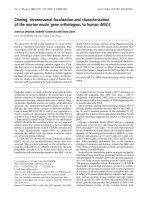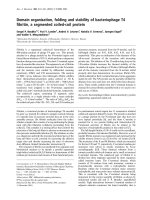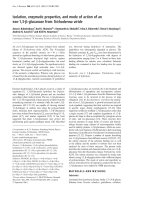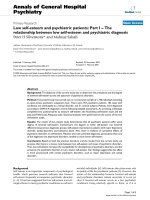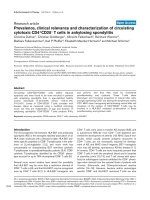Báo cáo y học: "Residual sleep disturbance and risk of relapse during the continuation/maintenance phase treatment of major depressive disorder with the selective serotonin reuptake inhibitor fluoxetine" docx
Bạn đang xem bản rút gọn của tài liệu. Xem và tải ngay bản đầy đủ của tài liệu tại đây (227.3 KB, 5 trang )
PRIMARY RESEARCH Open Access
Residual sleep disturbance and risk of relapse
during the continuation/maintenance phase
treatment of major depressive disorder with the
selective serotonin reuptake inhibitor fluoxetine
Huaiyu Yang
1*
, Lara Sinicropi-Yao
1
, Sarah Chuzi
1
, Soo Jeong Youn
1
, Alisabet Clain
1
, Lee Baer
1
, Ying Chen
2
,
Patrick J McGrath
2
, Maurizio Fava
1
, George I Papakostas
1
Abstract
Background: Relapse of major depressive disorder (MDD) is a common clinical problem. This study was designed
to determine whether residual sleep disturbance (insomnia and hypersomnia) predict risk of relapse during the
continuation and maintenance treatment of MDD.
Methods: A total of 570 patients with MDD were treated with open-label, flexible dose fluoxetine (range 20 to
60 mg; mean dose = 45.8 mg/day; SD = 15.1) for 12 weeks. Under double blind conditions, 262 patients who
achieved clinical response were randomly assigned to continue fluoxetin e or to switch to placebo for 52 weeks or
until relapse. Residual sleep disturbance during the baseline visit of the double-blind phase was assessed using
items 4, 5, 6 (insomnia) and 22, 23, 24 (hypersomnia) of the Hamilton Depression Rating Scale (HDRS). Survival
analysis was utilized to determine the effect of residual sleep disturbance on risk of relapse.
Results: The severities of early (P > 0.05), middle (P > 0.05), late (P > 0.05), or total (P > 0.05) residual insomnia
were not found to significantly predict risk of relap se during continuation and maintenance-phase treatment.
Similarly, the severities of early bedtime (P > 0.05), oversleeping (P > 0.05), napping (P > 0.05), or total (P > 0.05)
residual hypersomnia were not found to significantly predict risk of relapse during continuation and maintenance-
phase treatment.
Conclusion: The present study did not identify the severity of residual sleep disturbance among fluoxetine
responders to predict risk of MDD relapse. The size of our sample may have precluded us from identifying more
modest effects of residual sleep disturbance on the risk of relapse in MDD patients. Future studies are needed to
further explore the relationship between residual sleep disturbance and relapse in MDD.
Trial Registration: ClinicalTrials.gov Identifier: NCT00427128
Background
Major depressive disorder (MDD) is a prevalent and,
often recurrent illness that is associated with significant
disability, morbidity, and mortality. MDD, according to
the Diagnostic and Statistical Manual of Mental Disor-
ders, fourth edition (DSM-IV) [1,2], is diagnosed by the
presence of a constellation of symptoms including psy-
chological (that is, sadness), behavioral (that is, suicidal
gestures), cognitive (that is, concentration), and somatic/
physical symptoms (that is, sleep, energy, psychomotor,
and appetite disturbances). However, whether all depres-
sive symptoms weigh equally with regards to their
adverse impact on functioning, morbidity, mortality, and
treatment outcome or whether some symptoms are
more relevant than others remains, as of yet, undeter-
mined. Furthermore, although the goal of treating MDD
is to achieve full remission, it is common for many
patients to continue suffering from residual symptoms
after they respond to treatment [3]. Increasingly,
* Correspondence:
1
Depression Clinical and Research Program, Massachusetts General Hospital,
Harvard Medical School, Boston, MA, USA
Yang et al. Annals of General Psychiatry 2010, 9:10
/>© 2010 Yang et al; l icensee BioMed C entral Ltd. This is an Open Access a rticle distributed under the terms of the Cr eative Commons
Attribution License ( which permits unrestricted use, distribution, and reproductio n in
any medium, provided the original work is properly ci ted.
researchers and clinicians have advocated the impor-
tance of treating residual symptoms and of exploring
their neurobiological basis to develop better treatment
options and to improve MDD outcome [4].
Several studies published to date suggest that sleep
disturbance, namely insomnia and hypersomnia, may
represent suc h symptoms that weigh more heavily with
regards to their adverse impact on a number of out-
comes. Specifically, a number of studies report an
increased risk of subsequently developing MDD among
non-depressed individuals complaining of insomnia
(that is, insomnia may represent a prodromal symptom)
[5,6]. Similarly, Roberts et al. [7] found that non-
depr essed individuals experiencing hypersomnia were at
increased risk for developing MDD l ater on than indivi-
duals without hypersomnia. In addition, studies have
established a positive correlation between the presence
of sleep disturbance, including hypersom nia and insom-
nia, and a greater severity of depressive and anxiety
symptoms [8,9], as well as increased suicide rates
[10-12] among depressed patients. In addition, insomnia
and hypersomnia appear to be among the most com-
mon residual symptoms following selective serotonin
reuptake inhibitor (SSRI) treatment [13-15] and, often,
require t he use of specialized therapeutic interventions
above and beyond the use of antidepressant monother-
apy to ensure their ful l resolution [16-26]. Most impor-
tantly, there is preliminary evidence to suggest that
residual sleep disturbance at remission may be especially
deleterious w ith regards to its potential adverse impact
on relapse/recurrence in MDD. Dombrovski and collea-
gues [27], for instance, used data from a clinical trial of
maintenance treatment of lat e-life depression to analyze
the impact of overall residual symptom levels as well as
specific residual depressive symptom clusters on depres-
sive recurrence. Both residual anxiety and resid ual sleep
disturbance were found to be significant independent
predictors of early recurrence across treatment groups.
Identifying predictors of relapse in MDD is potentially
clinically relevant, since such predictors could lead to
the development of specialized treatment interventions
which could reduce the risk of relapse/recurrence in
MDD. Despite the encouraging results reported in the
work by Dombrovski et al. [27], so me studies have had
different findings. For example, one Sequenced Treat-
ment Alternatives to Relieve Depression (STAR*D)
report [28] suggests that the association between resi-
dual sleep disturbance and MDD recurrence is far from
being fully understood. For this reason, there is the
need for more studies specifically examining the role of
residual sleep disturbance as a predictor of relapse in
MDD.
Therefore, the purpose of the present study was to
explore the impact of residual sleep disturbance on the
risk of relapse of MD D during the continuation/m ainte-
nance treatment with the SSRI fluoxetine among fluoxe-
tine responders. In order to achieve this, we reanalyzed
data from a 52-week, randomized, double-blind, pla-
cebo-controlled trial of fluoxetine continuation/mainte-
nance treatment for MDD patients who had responded
following a 12-week, open-label, flexible dose trial of
fluoxetine. The original trial was specifically designed to
identify predictors of relapse during the continuation/
maintenance phase of MDD [29].
Methods
The present work is a post hoc analysis of data from a
clinical trial of fluoxetine in MDD [29]. For that trial,
627 patients, 18 to 65 years of age, with current MDD
definedusingDSM-IVcriteriawererecruitedatoneof
two sites: either the New York State Psychiatric Institute
in New York City, NY, USA (n = 372) or the Depression
Clinical and Research Program of the Massachusetts
General Hospital in Boston, MA, USA (n = 254). Insti-
tutional review boards at both sites approved the study,
and all participants provided written informed consent.
DiagnosesweremadeusingtheStructuredClinical
Interview f or DSM-IV Axis I Disorders, Patient Edition
(SCID-PE) [2] wit h no minimum score for severity of
depressive symptoms required for inclusion in the study.
Medical screening was performed, including medical
history, physical examination, electrocardiogram (ECG),
complete blood count (CBC), blood chemistry prof ile,
thyroid function tests, urinalysis, and urine drug screen.
Patients were excluded from the study if they were at
significant risk of suicide; were pregnant or breastfeed-
ing, were women not using effective contraception; had
an unstable physical disorder; had a lifetime history of
any organic mental disorder, psychotic disorder, or
mania; had a history of seizures; had a neurological dis-
order that significantly affects central nervous system
(CNS) function; had met criteria for substance abuse or
dependence in the previous 6 months, other than nico-
tine dependence; were taking medications that may
cause or exacerbate depression; had clinical or labora-
tory evidence of hypothyroidism without ad equate and
stable replacement therapy; or had a history of non-
response to an adequate trial of a SSRI (defined as a 4-
week trial o f ≥ 40 mg of fluo xetine or the equivalent
daily).
After a 1-week medication-free washout period,
patients (n = 570) who continued to meet inclusion
criteria and whose symptoms had not improved signifi-
cantly (Clinical Global Impressions-Improvement
(CGI-I) score >2) began a 12-week course of open-label
treatment with fluoxetine. Patients were evaluated by a
research psychiatrist weekly during the first 6 weeks,
biweekly for the next 4 weeks, and weekly for the final
Yang et al. Annals of General Psychiatry 2010, 9:10
/>Page 2 of 5
2 weeks. Target fluoxetine dosages were 10 mg/day for
the first week, 20 mg/day for weeks 2 to 4, 40 mg/day
for weeks 4 to 8, and 60 mg/day for weeks 5 to 12. The
dose was increased to meet the target only if the patient
tolerated the medication well, and it was increased to 40
mg daily for all patients who could tolerate it. Treat-
ment re sponse during the acute phase was defined as a
CGI-I [30] scale score less than 3 for the last two visits
of the open-label phase and no longer meeting DSM-IV
criteria for MDD (by SCID-PE).
Patients who re sponded to the medication by week 12
(n = 262) entered a discontinuation phase during which
they underwent random assignment, under double-blind
conditions with computer-generated randomization,
either to continue taking fluoxetine (n = 131) at the
dose to which they had responded or to switch to pla-
cebo (n = 131) for 52 weeks or until relapse. Patients
were seen monthly for the duration of the 52-week trial.
By convention, the first 6 months of this period were
considered the continuation phase, and the remainder,
the maintenance phase. Identical fluoxetine or placebo
capsules were dispensed by a research pharmacist. Com-
pliance was monitored by counting returned capsules;
participants whose adherence to the protocol was judged
inadequate by the treating research psychiatrist were
removed from the study. Relapse during the double-
blind discontinuation phase was defined as having at
least 2 consecutive weeks of ratings of less than ‘much
improved’ on the CGI-I compared with ratings at entry
into the study.
Residual sleep disturbance measure
The Hamilton Depression Rating Scale (HDRS) [31]
administered during the randomization visit (baseline
visit of the continuation and maintenance phase of the
study) was used to assess residual sleep disturbance.
Specifically, HDRS items 4 (early insomnia, that is diffi-
culty falling asleep), 5 (middle insomnia, that is awaken-
ings during night-time), 6 (late insomnia, that is early
morning awakenings) were utilized, 22 (early bedtime,
that is falling asleep earlier than usual), 23 (oversleeping,
that is waking up later than usual in the morning), and
24 (napping, that is daytime napping) were utilized.
Each item is scored as 0, 1, or 2.
Statistical tests
In order to test whe ther the presence of residual sleep
disturbance pred icted an increased risk of MDD relapse,
we conducted a survival analysis (Cox proportional
hazards regression), using SPSS 16.0 (SPSS Inc., Chi-
cago, IL, USA), with time to relapse as the dependent
variable and the following independent variables (1) the
17-item HD RS (HDRS-17) total score dur ing the rando-
mization visit (week 12), (2) gender, (3) chronicity (as
defined in McG rath et al. [29]), (4) and each individual
insomnia item score, each individual hypersomnia item
score, total insomnia burden (the sum of items 4, 5, and
6), or total hypersomnia burden (the sum of items 22,
23, and 24) entered separately. Gen der and chron icity
were ad ded to the model since they were found to pre-
dict risk of relapse (not differential by treatment) in the
original study [29]. Two-sided statistical tests were
employed, with alpha set at the 0.05 level of significance.
Results
Theresultsoftheoriginalstudyarereportedelsewhere
[29]. Briefly, the participants who underwent random
assignment were a mean age of 38.2 years (SD = 10.9),
and 55.3% were female. Their mean HDRS score was
17.1 (SD = 4.1) at baseline and 4.9 (SD = 3.1) at rando-
mization; 22.7% of them had a history of dysthymia and
thus curren tly had ‘double depression ’ . About two-thirds
(35%) of the participants had one or more comorbid
axis I disorder, most commonly panic disorder (13.3 %),
social phobia (12.4%), and alcohol dependence (10.6%).
During this phase, 85 participants left the study, on
average 16.4 weeks (SD = 2.0) after randomization; 34
of them were from the placebo group (26.0% of the pla-
cebo group), and 51 were from the fluoxetine group
(38.9%). The most common reasons for leaving during
this phase were removal for inadequate adherence
(30.6% of those who left the study), loss to follow-up
(14.1%), and side effects (7.1%). Fluoxetine treatment
during continuation and maintenance treatment was
associated with continued remission (ratio of relapse
hazard during placebo substitution to relapse hazard
during fluoxetine continuation = 1.73; 95% CI 1.20 to
2.51). The relapse rates at the end of the cont inuation
phase (6 months after randomization) were 35.2% for
the fluoxetine group and 61.8% for the placebo group;
after 1 y ear, they were 45. 9% for t he fluoxetine group
and 72.0% for the placebo group.
Mean (SD) residual insomnia scores among during the
baseline visit of the double-blind phase were as follows:
early insomnia 0.46 (0.77), middle insomnia 0.54 (0.75),
late insomnia 0.50 (0.74), total insomnia 1.50 (1.68).
Mean (SD) severity of residual hypersomnia scores
among during the baseline visit of the double-blind
phase were as follows: early bedtime 0.16 (0.45), over-
sleeping 0.22 (0.49), daytime napping 0.34 (0.59), total
hypersomnia 0.71 (1.00).
The severities of early (hazard ratio = 0.80; P = 0.19),
middle (hazard ratio = 1.00; P = 0.99), late (hazard ratio
=0.99;P = 0.95), and total insomnia (hazard ratio =
0.95; P = 0.53) were not found to predict risk of relapse.
Similarly, the severities of early bedtime (hazard ratio =
1.19; P = 0.44), oversleeping (hazard ratio = 1. 23; P =
0.30), daytime napping (hazard ratio = 1.10; P =0.52),
Yang et al. Annals of General Psychiatry 2010, 9:10
/>Page 3 of 5
and total hypersomnia (hazard ratio = 1.10; P =0.34)
were not found to predict risk of relapse.
Conclusions
The present study is the first to specifically focus on test-
ing the effects of residual sleep disturbance, including
insomnia and hypersomnia, as a predictor of relapse dur-
ing the continuation and maintenance treatment of MDD
with the SSRI fluoxetine or placebo. In addition, although
several studies have explored the relationship between
clinical presentation during recovery from a major depres-
sive episode and the risk of subsequent relapse, the present
study is the first to be specifically designed to identify
predictors of relapse in MDD. In summary, the results of
the present analysis do not suggest that a greater burden
of residual sleep disturbance is associated with a higher
risk of relapse among fluoxetine responders with MDD
during the continuation/maintenance phase of treatment
with either fluoxetine or placebo.
While the ab ove findings are q uite interesting, several
limitations to this study need to be considered in inter-
preting the results. Clinical trials, including the present
one, typically involve a number of inclusion and excl u-
sion criteria, and it is therefore not po ssible to extend
findings from clinical trials to patient populations typi-
cally excluded form clinical trials (that is, patients who
are actively suicidal, with psychotic symptoms, with
uncontrolled medical illness, or with bipolar disorder).
In addition, although the present trial did not identify a
robust relationship between residual sleep disturbance
and time to depressive relapse, it may have been under-
powered to identify weaker effects of such residual
symptoms on long-term treatment outcome. Therefore,
the present results are, merely, preliminary/suggestive
and need to be confirmed by future studies. Finally, the
present study did not employ a second, ‘active’ treat-
ment arm. It would have been interesting to explore
whether or not a similar relationship between specific
residual insomnia and risk of relapse would also hold
for antidepressants that employ a differe nt mechanism
of action. In addition, the dependence of MDD residual
symptoms on ot her factors such as caffeine inta ke and
diurnal variation of depressive symptoms (such data was
not available from the original study f or us to analyze)
would be interesting to include in future research. Ulti-
mately, the exploration of neurobiological markers of
MDD including residual symptoms will be essential to
advance our knowledge of this disabling condition,
which will lead to the development of new diagnostic
classification, treatment and prevention.
In conclusion, the present study did not identify the
severity of residual sleep disturbance among fluoxetine
responders to predict a higher risk of MDD relapse. The
size of our sample may have precluded us from identify-
ing more modest effects of residual sleep disturbance on
theriskofrelapseinMDDpatients.Futurestudiesare
needed to further explore the relationship between resi-
dual sleep disturbance and relapse in MDD.
Author details
1
Depression Clinical and Research Program, Massachusetts General Hospital,
Harvard Medical School, Boston, MA, USA.
2
Depression Evaluation Service
Center, New York State Psychiatric Institute, Columbia University, New York,
NY, USA.
Authors’ contributions
HY conceptualized the study, participated in the preparation of the
manuscript and provided critical review of the manuscript. LSY participated
in the editing of the manuscript. SC contributed in the literature search and
in the preparation of the manuscript. SJY contributed in the review of the
manuscript. YC was the statistician for the original study, and helped
interpret the data for the current study. AC and LB conducted the statistical
analysis. PJM and MF were the principal investigators of the original study
and provided critical review of the study. GIP oversaw the whole project
from study design to data interpretation as well as manuscript revision
Competing interests
HY, LSY, SC, SJY, YC, AC, and LB declare that they have no competing
interests. PJM has received research support from the National Institute of
Mental Health, National Institute on Alcohol Abuse and Alcoholism, New
York State Department of Mental Hygiene, NARSAD, Research Foundation for
Mental Hygiene (New York State), GlaxoSmithKline, Eli Lilly, Organon and
Lipha Pharmaceuticals, and has worked in an advisory/consulting capacity
for GlaxoSmithKline, Somerset Pharmaceuticals, Novartis Pharmaceuticals
(2008), Sanofi Aventis (2007) and Roche (2008), MF has received research
support from Abbott Laboratories, Alkermes, Aspect Medical Systems, Astra-
Zeneca, Bristol-Myers Squibb Company, Cephalon, Eli Lilly & Company, Forest
Pharmaceuticals Inc., GlaxoSmithKline, J & J Pharmaceuticals, Lichtwer
Pharma GmbH, Lorex Pharmaceuticals, Novartis, Organon Inc., PamLab, LLC,
Pfizer Inc, Pharmavite, Roche, Sanofi Aventis, Solvay Pharmaceuticals, Inc. and
Synthelabo, Wyeth-Ayerst Laboratories, has worked in an advisory/consulting
capacity for Abbott Laboratories, Amarin, Aspect Medical Systems, Astra-
Zeneca, Auspex Pharmaceuticals, Bayer AG, Best Practice Project
Management, Inc., Biovail Pharmaceuticals, Inc., BrainCells, Inc. Bristol-Myers
Squibb Company, Cephalon, CNS Response, Compellis, Cypress
Pharmaceuticals, Dov Pharmaceuticals, Eli Lilly & Company, EPIX
Pharmaceuticals, Fabre-Kramer Pharmaceuticals, Inc., Forest Pharmaceuticals
Inc., GlaxoSmithKline, Grunenthal GmBH, Janssen Pharmaceutica, Jazz
Pharmaceuticals, J & J Pharmaceuticals, Knoll Pharmaceutical Company,
Lorex Pharmaceuticals, Lundbeck, MedAvante, Inc., Merck, Neuronetics,
Novartis, Nutrition 21, Organon Inc., PamLab, LLC, Pfizer Inc, PharmaStar,
Pharmavite, Precision Human Biolaboratory, Roche, Sanofi Aventis, Sepracor,
Solvay Pharmaceuticals, Inc., Somaxon, Somerset Pharmaceuticals,
Synthelabo, Takeda, Tetragenex, Transcept Pharmaceuticals, Vanda
Pharmaceuticals Inc, Wyeth-Ayerst Laboratories, has been a speaker for Astra-
Zeneca, Boehringer-Ingelheim, Bristol-Myers Squibb Company, Cephalon, Eli
Lilly & Company, Forest Pharmaceuticals Inc., GlaxoSmithKline, Novartis,
Organon Inc., Pfizer Inc, PharmaStar, Primedia, Reed-Elsevier and Wyeth-
Ayerst Laboratories, has equity holdings in Compellis and MedAvant e, and
has the following royalties/patents or other income: patent applications for
SPCD and for a combination of azapirones and bupropion in MDD,
copyright royalties for the MGH CPFQ, DESS, and SAFER. GIP has served as a
consultant to Bristol-Myers Squibb, Eli Lilly, GlaxoSmithKline, Evotec, Inflabloc
Pharmaceuticals, Jazz Pharmaceuticals, Pamlab, Pfizer, Pierre Fabre, Shire and
Wyeth, has received honoraria from Bristol-Myers Squibb, Eli Lilly, Evotec,
GlaxoSmithKline, Inflabloc Pharmaceuticals, Jazz Pharmaceuticals, Lundbeck,
Pamlab, Pfizer, Pierre Fabre, Shire, Titan Pharmaceuticals and Wyeth, has
received research support from Bristol-Myers Squibb, Forest, National
Institute of Mental Health, Pamlab, Pfizer and Precision Human
Biolaboratories, and has served on the speakers bureau for Bristol-Myers
Squibb and Pfizer.
Yang et al. Annals of General Psychiatry 2010, 9:10
/>Page 4 of 5
Received: 14 July 2009
Accepted: 26 February 2010 Published: 26 February 2010
References
1. American Psychiatric Association: Diagnostic and Statistical Manual of
Mental Disorders. Washington, DC, USA: American Psychiatric Association,
4 1994.
2. First MB, Spitzer RL, Gibbon M, Williams JBW: Structured Clinical Interview
for DSM-IV Axis I Disorders - Patient Edition (SCID-I/P, Version 2.0). New
York, NY, USA: Biometrics Research Department, New York State Psychiatric
Institute 1995.
3. Trivedi MH, Rush AJ, Wisniewski SR, Nierenberg AA, Warden D, Ritz L,
Norquist G, Howland RH, Lebowitz B, McGrath PJ, Shores-Wilson K,
Biggs MM, Balasubramani GK, Fava M, STAR*D Study Team: Evaluation of
outcomes with Citalopram for depression using measurement-based
care in STAR*D: implications for clinical practice. Am J Psychiatry 2006,
163:28-40.
4. Trivedi MH, Hollander E, Nutt D, Blier P: Clinical evidence and potential
neurobiological underpinnings of unresolved symptoms of depression. J
Clin Psychiatry 2008, 69:246-258.
5. Fava GA, Grandi S, Canestrari R, Molnar G: Prodromal symptoms in
primary major depressive disorder. J Affect Disord 1990, 19(Suppl
2):149-152.
6. Perlis ML, Smith LJ, Lyness JM, Matteson SR, Pigeon WR, Jungquist CR, Tu X:
Insomnia as a risk factor for onset of depression in the elderly. Behav
Sleep Med 2006, 4(Suppl 2):104-113.
7. Roberts RE, Shema SJ, Kaplan GA, Strawbridge WJ: Sleep complaints and
depression in an aging cohort: a prospective perspective. Am J Psychiatry
2000, 157(Suppl 1):81-88.
8. Liu X, Buysse DJ, Gentzler AL, Kiss E, Mayer L, Kapornai K, Vetró A, Kovacs M:
Insomnia and hypersomnia associated with depressive phenomenology
and comorbidity in childhood depression. Sleep 2007, 30(Suppl 1):83-90.
9. Taylor DJ, Lichstein KL, Durrence HH, Reidel BW, Bush AJ: Epidemiology of
insomnia, depression, and anxiety. Sleep 2005, 28(Suppl 11):1457-1464.
10. Goldstein TR, Bridge JA, Brent DA: Sleep disturbance preceding
completed suicide in adolescents. J Consult Clin Psychol 2008, 76(Suppl
1):84-91.
11. McGirr A, Renaud J, Seguin M, Alda M, Benkelfat C, Lesage A, Turecki G: An
examination of DSM-IV depressive symptoms and risk for suicide
completion in major depressive disorder: a psychological autopsy study.
J Affect Disord 2007, 97(Suppl 1-3):203-209.
12. Chellappa SL, Araújo JF: Sleep disorders and suicidal ideation in patients
with depressive disorder. Psychiatry Res 2007, 153(Suppl 2):131-136.
13. Nierenberg AA, Keefe BR, Leslie VC, Alpert JE, Pava JA, Worthington JJ,
Rosenbaum JF, Fava M: Residual symptoms in depressed patients who
respond acutely to fluoxetine. J Clin Psychiatry 1999, 60(Suppl 4):221-225.
14. Fava M, Graves LM, Benazzi F, Scalia MJ, Iosifescu DV, Alpert JE,
Papakostas GI: A cross-sectional study of the prevalence of cognitive and
physical symptoms during long-term antidepressant treatment. J Clin
Psychiatry 2006, 67(Suppl 11):1754-1759.
15. Worthington J, Fava M, Davidson K, Alpert J, Nierenberg AA, Rosenbaum JF:
Patterns of improvement in depressive symptoms with fluoxetine
treatment. Psychopharmacol Bull 1995, 31(Suppl 2):223-226.
16. Manber R, Edinger JD, Gress JL, San Pedro-Salcedo MG, Kuo TF, Kalista T:
Cognitive behavioral therapy for insomnia enhances depression
outcome in patients with comorbid major depressive disorder and
insomnia. Sleep 2008, 31(Suppl 4):489-495.
17. Fava M, Asnis GM, Shrivastava R, Lydiard B, Bastani B, Sheehan D, Roth T:
Zolpidem extended-release improves sleep and next-day symptoms in
comorbid insomnia and generalized anxiety disorder. J Clin
Psychopharmacol 2009, 29(3):222-30.
18. Fava M, McCall WV, Krystal A, Wessel T, Rubens R, Caron J, Amato D, Roth T:
Eszopiclone co-administered with fluoxetine in patients with insomnia
coexisting with major depressive disorder. Biol Psychiatry 2006, 59(Suppl
11):1052-1060.
19. Asnis GM, Chakraburtty A, DuBoff EA, Krystal A, Londborg PD, Rosenberg R,
Roth-Schechter B, Scharf MB, Walsh JK: Zolpidem for persistent insomnia
in SSRI-treated depressed patients. J Clin Psychiatry 1999, 60(Suppl
10):668-676.
20. Ji JL, Liu WJ, Zhang N, Chen ZQ, Zheng AL, Mei QY, Pan JY, Zhao ZX,
Tao M, Wang YP, Wei J: Effects of paroxetine with or without zolpidem
on depression with insomnia: a multi-center randomized comparative
study. Zhonghua Yi Xue Za Zhi 2007, 87(Suppl 23):1585-1589.
21. Dolberg OT, Hirschmann S, Grunhaus L: Melatonin for the treatment of
sleep disturbances in major depressive disorder. Am J Psychiatry 1998,
155(Suppl 8):1119-1121.
22. Nierenberg AA, Adler LA, Peselow E, Zornberg G, Rosenthal M: Trazodone
for antidepressant-associated insomnia. Am J Psychiatry 1994, 51(Suppl
7):1069-1072.
23. Papakostas GI, Petersen TJ, Burns AM, Fava M: Adjunctive atomoxetine for
residual fatigue in major depressive disorder. J Psychiatr Res 2006,
40(Suppl 4):370-373.
24. Papakostas GI, Nutt DJ, Hallett LA, Tucker VL, Krishen A, Fava M: Resolution
of sleepiness and fatigue in major depressive disorder: a comparison of
bupropion and the selective serotonin reuptake inhibitors. Biol Psychiatry
2006, 60(Suppl 12):1350-1355.
25. Fava M, Thase ME, DeBattista C, Doghramji K, Arora S, Hughes RJ: Modafinil
augmentation of selective serotonin reuptake inhibitor therapy in MDD
partial responders with persistent fatigue and sleepiness. Ann Clin
Psychiatry 2007, 19(Suppl 3):153-159.
26. Ravindran AV, Kennedy SH, O’Donovan MC, Fallu A, Camacho F, Binder CE:
Osmotic-release oral system methylphenidate augmentation of
antidepressant monotherapy in major depressive disorder: results of a
double-blind, randomized, placebo-controlled trial. J Clin Psychiatry 2008,
69(Suppl 1):87-94.
27. Dombrovski AY, Mulsant BH, Houck PR, Mazumdar S, Lenze E, Andreescu C,
Cyranowski J, Reynolds C: Residual symptoms and recurrence during
maintenance treatment of late life depression. J Affect Disord 2007,
103:77-82.
28. Nierenberg AA, Husain MM, Trivedi MH, Fava M, Warden D, Wisniewski SR,
Miyahara S, Rush AJ: Residual symptoms after remission of major
depressive disorder with citalopram and risk of relapse: a STAR*D
report. Psychol Med 2010, 40:41-50.
29. McGrath PJ, Stewart JW, Quitkin FM, Chen Y, Alpert JE, Nierenberg AA,
Fava M, Cheng J, Petkova E: Predictors of relapse in a prospective study
of fluoxetine treatment of major depression. Am J Psychiatry 2006,
163:1542-1548.
30. Guy W, (Ed): ECDEU Assessment Manual for Psychopharmacology,
revised. Rockville, MD, USA: National Institute of Mental Health 1976.
31. Hamilton M: A rating scale for depression. J Neurol Neurosurg Psychiatry
1960, 23:56-62.
doi:10.1186/1744-859X-9-10
Cite this article as: Yang et al.: Residual sleep disturbance and risk of
relapse during the continuation/maintenance phase treatment of major
depressive disorder with the selective serotonin reuptake inhibitor
fluoxetine. Annals of General Psychiatry 2010 9:10.
Submit your next manuscript to BioMed Central
and take full advantage of:
• Convenient online submission
• Thorough peer review
• No space constraints or color figure charges
• Immediate publication on acceptance
• Inclusion in PubMed, CAS, Scopus and Google Scholar
• Research which is freely available for redistribution
Submit your manuscript at
www.biomedcentral.com/submit
Yang et al. Annals of General Psychiatry 2010, 9:10
/>Page 5 of 5
